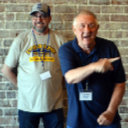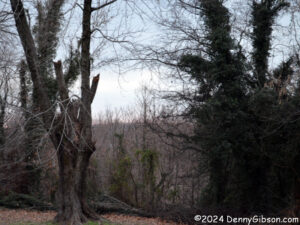 When I got the email about a preview of a new exhibit at Ohio History Connection, I quickly signed up. Only as the date approached and I started looking into the exhibit did I realize that, while I would get to preview the opening of “St. Clair’s Defeat Revisited: A New View of the Conflict,” this would not be the exhibit’s premiere. That had occurred at the Fort Recovery Museum, the actual site of St. Clair’s Defeat, in November of 2023. After spending about two months at Fort Recovery, the exhibit had appeared for nearly four months in Fort Wayne, IN, and more than six months in Miami, OK. The opening I was previewing was its fourth.
When I got the email about a preview of a new exhibit at Ohio History Connection, I quickly signed up. Only as the date approached and I started looking into the exhibit did I realize that, while I would get to preview the opening of “St. Clair’s Defeat Revisited: A New View of the Conflict,” this would not be the exhibit’s premiere. That had occurred at the Fort Recovery Museum, the actual site of St. Clair’s Defeat, in November of 2023. After spending about two months at Fort Recovery, the exhibit had appeared for nearly four months in Fort Wayne, IN, and more than six months in Miami, OK. The opening I was previewing was its fourth.

 The disappointment I felt in this not being the world premiere I initially thought it was, was outweighed by my embarrassment in not knowing of the true world premiere that had happened more than a year before. Food and drink were pretty good compensation, however, and both disappointment and embarrassment were pretty much forgotten at the member’s reception.
The disappointment I felt in this not being the world premiere I initially thought it was, was outweighed by my embarrassment in not knowing of the true world premiere that had happened more than a year before. Food and drink were pretty good compensation, however, and both disappointment and embarrassment were pretty much forgotten at the member’s reception.
 The member’s preview also included a panel presentation and a question and answer session. Bill, whose last name I failed to record, acted as MC, while Kim Rammel and Dr. Kristen Barry supplied the information. Rammel is president of the Fort Recovery Historical Society. Barry is a professor at Ball State University and a member of the team responsible for the exhibit.
The member’s preview also included a panel presentation and a question and answer session. Bill, whose last name I failed to record, acted as MC, while Kim Rammel and Dr. Kristen Barry supplied the information. Rammel is president of the Fort Recovery Historical Society. Barry is a professor at Ball State University and a member of the team responsible for the exhibit.
It has been said that history is written by the victors, but while that is generally true of wars, it isn’t always true of individual battles. The “new view” this exhibit provides comes from descendants of the nine Native American tribes that nearly annihilated the entire United States army in 1791. Specific details of the battle differ very little as related by the two sides, but there are differences in its overall assessment. Virtually every description of the battle that I have read attributes the overwhelming success of the native force to errors, poor training, and incompetence on the part of the Americans. Those certainly contributed, but the native’s brilliant plan of attack and its near-perfect execution were at the heart of their victory.


 It was great to see the event so well attended even though it meant space to study the exhibits was in short supply. l snapped these pictures during the reception period when the display area was not quite as crowded as it was following the presentation in the auditorium. In addition to the battle, parts of the exhibit are dedicated to Background, Aftermath, and Persistence. The victory brought only a brief respite. In just a few years, a new U.S. Army was victorious at the same site and elsewhere, and the Treaty of Greenville soon followed. The Indian Removal Act of 1830 was followed by forced relocation and the systematic suppression of native culture. The tribes have survived, however. This exhibit spent those months in Oklahoma so descendants of the people who defeated St. Clair could see it.
It was great to see the event so well attended even though it meant space to study the exhibits was in short supply. l snapped these pictures during the reception period when the display area was not quite as crowded as it was following the presentation in the auditorium. In addition to the battle, parts of the exhibit are dedicated to Background, Aftermath, and Persistence. The victory brought only a brief respite. In just a few years, a new U.S. Army was victorious at the same site and elsewhere, and the Treaty of Greenville soon followed. The Indian Removal Act of 1830 was followed by forced relocation and the systematic suppression of native culture. The tribes have survived, however. This exhibit spent those months in Oklahoma so descendants of the people who defeated St. Clair could see it.
Two smaller versions of the exhibit have been created. One is on permanent display at Fort Recovery. The other will travel and is currently at the Hopewell Culture National Historical Park near Chillicothe, OH, where it will remain until April 13. The exhibit at the Ohio History Connection runs until August 17.

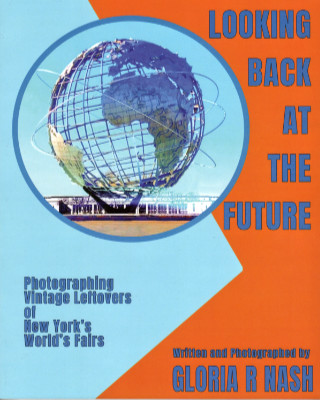 Before I even opened this book I was aware of Gloria Nash’s childhood fascination with the 1964 World’s Fair, the family circumstances that brought her back to the neighborhood, and her visits to the old fairgrounds that ultimately led to creating Looking Back at the Future. I was not aware of a high school photography class assignment to “locate and photograph remnants of the fair” that had recently closed. A few black-and-white pictures taken at that time are included in this volume where she wraps up that assignment in style.
Before I even opened this book I was aware of Gloria Nash’s childhood fascination with the 1964 World’s Fair, the family circumstances that brought her back to the neighborhood, and her visits to the old fairgrounds that ultimately led to creating Looking Back at the Future. I was not aware of a high school photography class assignment to “locate and photograph remnants of the fair” that had recently closed. A few black-and-white pictures taken at that time are included in this volume where she wraps up that assignment in style. The book’s subtitle, “Photographing Vintage Leftovers of New York’s World’s Fairs”, accurately describes its main thrust. Well-written text provides background on both fairs, and there are descriptions of buildings and other items that no longer exist, but photographs of what that subtitle calls “leftovers” fill the bulk of the book. Most were taken by the author although a few come from other sources. Some images from postcards and other promotional materials are also used sparingly. The book is printed on good quality fairly heavy stock but it is not coated gloss stock. All of the modern photos are bright and clear and look quite good but this is not a “coffee table” book.
The book’s subtitle, “Photographing Vintage Leftovers of New York’s World’s Fairs”, accurately describes its main thrust. Well-written text provides background on both fairs, and there are descriptions of buildings and other items that no longer exist, but photographs of what that subtitle calls “leftovers” fill the bulk of the book. Most were taken by the author although a few come from other sources. Some images from postcards and other promotional materials are also used sparingly. The book is printed on good quality fairly heavy stock but it is not coated gloss stock. All of the modern photos are bright and clear and look quite good but this is not a “coffee table” book.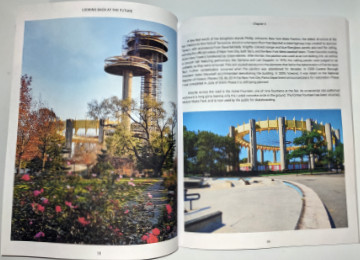 Nash has done a phenomenal job in tracking down fair remnants and makes sure that others can “locate and photograph” these leftovers, too. The location of all leftovers at the fair site (now Flushing Meadows Corona Park) is shown on a map with color coding to distinguish 1939 leftovers from 1964 leftovers. Both chapters on “On-Site Leftovers” contain what amounts to a tour guide for a walk that visits each of them. Chapters on “Off-Site Leftovers” describe locations and give addresses where appropriate. An appendix provides these locations in a list format.
Nash has done a phenomenal job in tracking down fair remnants and makes sure that others can “locate and photograph” these leftovers, too. The location of all leftovers at the fair site (now Flushing Meadows Corona Park) is shown on a map with color coding to distinguish 1939 leftovers from 1964 leftovers. Both chapters on “On-Site Leftovers” contain what amounts to a tour guide for a walk that visits each of them. Chapters on “Off-Site Leftovers” describe locations and give addresses where appropriate. An appendix provides these locations in a list format.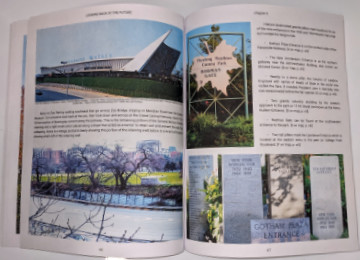 Although both of these fairs made lasting impressions on the people who attended them. neither was a success from the organizers’ point of view. Organizers in 1939 hoped for 50 million visitors but got only 45 million. The target in 1964 was 70 million, but only 51 million showed up. I wasn’t around in 1939, and even though I was very much around in 1964 and well aware of the fair, I did not attend. I have only attended one world’s fair in my life, and that was in 1983 in Knoxville, TN. Nash says that was the last profitable world’s fair held in this country. Coincidence?
Although both of these fairs made lasting impressions on the people who attended them. neither was a success from the organizers’ point of view. Organizers in 1939 hoped for 50 million visitors but got only 45 million. The target in 1964 was 70 million, but only 51 million showed up. I wasn’t around in 1939, and even though I was very much around in 1964 and well aware of the fair, I did not attend. I have only attended one world’s fair in my life, and that was in 1983 in Knoxville, TN. Nash says that was the last profitable world’s fair held in this country. Coincidence?
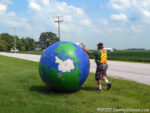

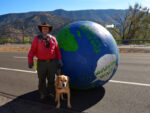
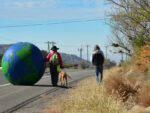
 I’ve been anticipating this book for a few years now. Henry was probably well into his research for the book when he gave a presentation at the 2017 Lincoln Highway Association conference on trekkers who had incorporated all or part of the highway in their travels. The Lincoln Highway and other trails aimed at automobiles appeared in the latter half of the golden age of trekking, which Trekking Across America focuses on. Henry identifies this as roughly 1890 to 1930. Merriam-Webster defines a trek as “an arduous journey” and during that period just about any long-distance journey that did not involve the railroad was unquestionably arduous. I ordered the book as soon as I became aware of its publication but my own non-arduous travels and the winter holidays kept me from reading and reviewing it until now.
I’ve been anticipating this book for a few years now. Henry was probably well into his research for the book when he gave a presentation at the 2017 Lincoln Highway Association conference on trekkers who had incorporated all or part of the highway in their travels. The Lincoln Highway and other trails aimed at automobiles appeared in the latter half of the golden age of trekking, which Trekking Across America focuses on. Henry identifies this as roughly 1890 to 1930. Merriam-Webster defines a trek as “an arduous journey” and during that period just about any long-distance journey that did not involve the railroad was unquestionably arduous. I ordered the book as soon as I became aware of its publication but my own non-arduous travels and the winter holidays kept me from reading and reviewing it until now.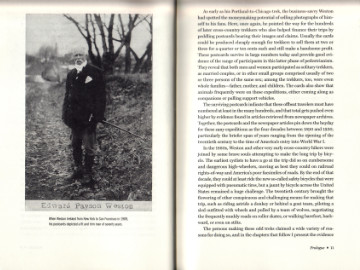 A fellow named Edward Weston is credited with getting the walking craze started by walking from Boston to Washington to satisfy a bet made on the wrong guy (Stephen Douglas) in the 1860 presidential election. Apparently, Weston decided that he really liked walking and was quite good at it. He proceeded to set records and win awards into his seventies. In some circles, the rampant pedestrianism of the time was referred to as Westonianism.
A fellow named Edward Weston is credited with getting the walking craze started by walking from Boston to Washington to satisfy a bet made on the wrong guy (Stephen Douglas) in the 1860 presidential election. Apparently, Weston decided that he really liked walking and was quite good at it. He proceeded to set records and win awards into his seventies. In some circles, the rampant pedestrianism of the time was referred to as Westonianism.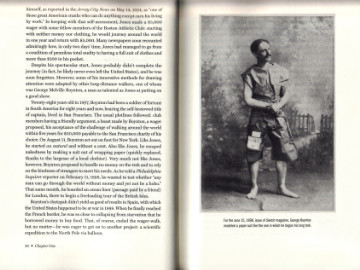 Postcards are also a rather natural way to provide a visual connection with a trek’s story. Henry divides these stories into five chapters based — not all that rigidly — on the reason for the trek. Following a chapter’s introduction are several segments featuring one or two specific treks with at least one related image. Postcards often provide those images. These two or three page standalone segments allow “Trekking Across America” to be read in small doses if desired.
Postcards are also a rather natural way to provide a visual connection with a trek’s story. Henry divides these stories into five chapters based — not all that rigidly — on the reason for the trek. Following a chapter’s introduction are several segments featuring one or two specific treks with at least one related image. Postcards often provide those images. These two or three page standalone segments allow “Trekking Across America” to be read in small doses if desired.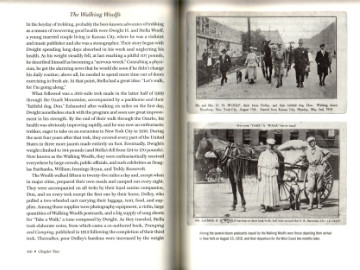 Individual males were hardly the only ones undertaking these long arduous journeys. Buddies, siblings, newlyweds, whole families, and even a few lone women appear on these pages. Incidentally, little evidence is presented here that a trekking honeymoon will lead to marital bliss. The rules for some of the contests and challenges were also interesting. Virtually every trek involved some sort of time limit but rules about clothing, starting with little or no money, and working en route were also common. After the turn of the century, gimmicks such as the aforementioned skating or rolling a hoop might be involved. One fellow fiddled every step of the way as he walked from New York to Los Angeles and on to San Francisco.
Individual males were hardly the only ones undertaking these long arduous journeys. Buddies, siblings, newlyweds, whole families, and even a few lone women appear on these pages. Incidentally, little evidence is presented here that a trekking honeymoon will lead to marital bliss. The rules for some of the contests and challenges were also interesting. Virtually every trek involved some sort of time limit but rules about clothing, starting with little or no money, and working en route were also common. After the turn of the century, gimmicks such as the aforementioned skating or rolling a hoop might be involved. One fellow fiddled every step of the way as he walked from New York to Los Angeles and on to San Francisco. Peter Yarrow died this week, and the news brought back some memories that he is a part of. Peter’s main claim to fame was his time with Peter, Paul, and Mary whom I saw twice. I also saw Mary Travers in a solo performance once. Of course, the bulk of my memories come from listening to the trio on the radio and on vinyl.
Peter Yarrow died this week, and the news brought back some memories that he is a part of. Peter’s main claim to fame was his time with Peter, Paul, and Mary whom I saw twice. I also saw Mary Travers in a solo performance once. Of course, the bulk of my memories come from listening to the trio on the radio and on vinyl. ADDENDUM 4-May-2025: Writing this naturally renewed thoughts of those long-ago events, and when I learned I could access some Cincinnati Enquirer archives through my local library, I went looking. Here is the last paragraph of Cliff Radel’s February 18, 1980, article. Cliff’s day-old memory was better than my 45-year-old one. It was Peter rather than Paul who intervened on my behalf, and I’ve corrected that above. On the other hand, I feel obliged to reiterate that I and the flasher were two different people, regardless of whether either of us was a photographer.
ADDENDUM 4-May-2025: Writing this naturally renewed thoughts of those long-ago events, and when I learned I could access some Cincinnati Enquirer archives through my local library, I went looking. Here is the last paragraph of Cliff Radel’s February 18, 1980, article. Cliff’s day-old memory was better than my 45-year-old one. It was Peter rather than Paul who intervened on my behalf, and I’ve corrected that above. On the other hand, I feel obliged to reiterate that I and the flasher were two different people, regardless of whether either of us was a photographer.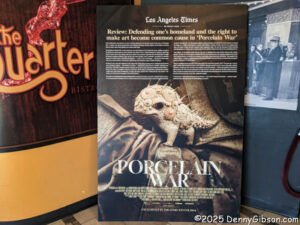
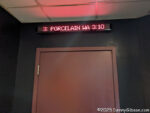
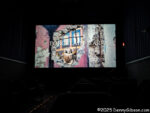
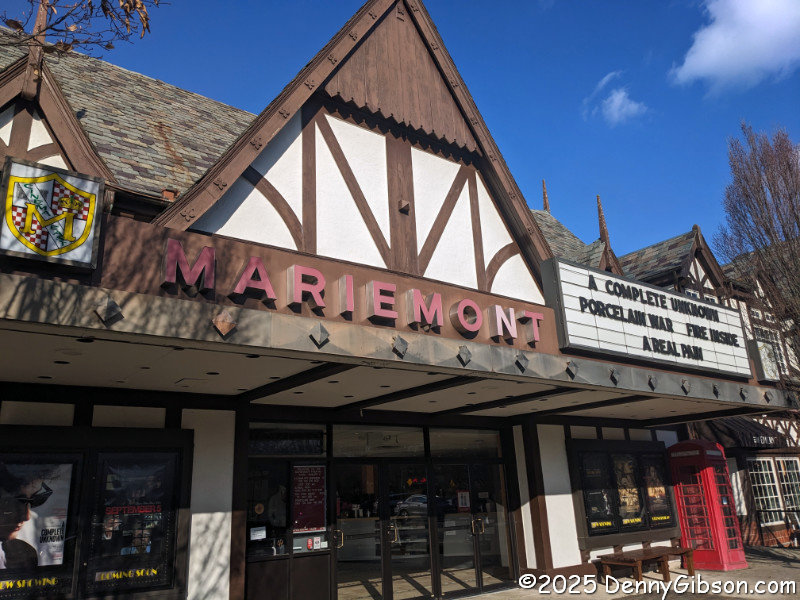 It looks like tomorrow (Jan 9) is the last day
It looks like tomorrow (Jan 9) is the last day 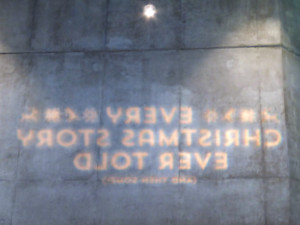 Last year I wrote that everything went up except interest. This year even that increased with more visits to both the blog and the trip journals than in 2023. I made the same number of trips as last year but spent over three weeks more on them. That is undoubtedly why road trip pictures are up and probably why blog posts and pictures are down. There were just eight reviews published in 2024 compared to sixteen in 2023, and that is a big part of the difference. The number one post on both the blog and non-blog lists is a repeat of last year. In fact, both lists have four of last year’s entries returning this year. Could that be a sign of website maturity? Stagnation? Irrelevance?
Last year I wrote that everything went up except interest. This year even that increased with more visits to both the blog and the trip journals than in 2023. I made the same number of trips as last year but spent over three weeks more on them. That is undoubtedly why road trip pictures are up and probably why blog posts and pictures are down. There were just eight reviews published in 2024 compared to sixteen in 2023, and that is a big part of the difference. The number one post on both the blog and non-blog lists is a repeat of last year. In fact, both lists have four of last year’s entries returning this year. Could that be a sign of website maturity? Stagnation? Irrelevance?